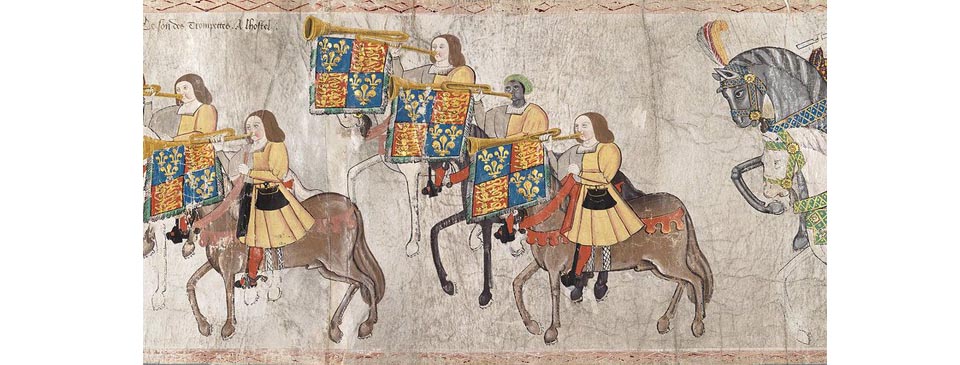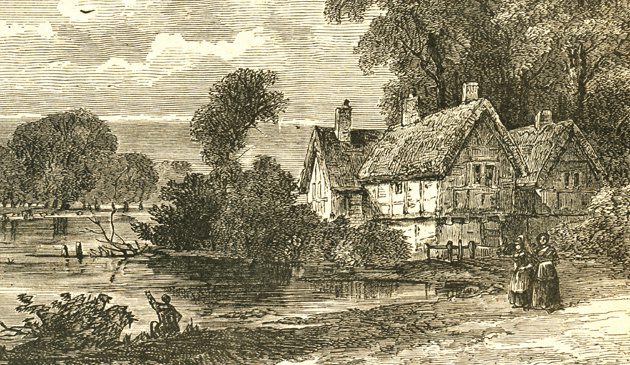Africans in London in the 16th century and the early slave trade

Africans were certainly living in England by the 16th century. A confirmation is within the Westminster Tournament Roll of 1511 where John Blanke is depicted as one of Henry VIII’s trumpeters.
Not all Africans were treated as slaves. Southern European monarchs had African musicians at their courts. England was still a minor nation during the 16th century and thus to have an African musician would be one way of increasing prestige and emulating the greater courts of other more powerful states. The African John Blanke is recorded as being a trumpeter at the court of Henry VII. It is not clear how he arrived in England but he may have been one of the two slaves listed as accompanying Katherine of Aragon when she came from Spain to marry Henry’s eldest son Arthur. However, Henry did not accept the concept of slavery in England and had previously set free the Portuguese slave Pero Alvarez. Blanke was certainly paid a wage for his services. Henry died in 1509 and Blanke was one of the trumpeters at his funeral at Westminster Abbey and the subsequent coronation at the Abbey of Henry VIII and Catherine of Aragon.
Unlike other countries, and in the American colonies in later times, slavery was never codified in England. Various legal disputes have cited a case from 1569 in which a man was brought to court for whipping his slave who he claimed to have brought to England from Russia. The judgement was “that England was too pure an Air for a Slave to breathe in”. However, that may have referred to the level of violence towards the slave rather than about slavery itself.
The rector William Harrison certainly believed slavery was absent in England. In his Description of England, published in 1577, he stated:
As for slaves and bondmen, we have none; nay such is the privilege of our country by the especial grace of God and bounty of our princes, that if any come hither from other realms, so soon as they set foot on land they become as free in condition as their masters, whereby all note of servile bondage is utterly removed from them.
There is much evidence of some Africans living freely in London and elsewhere in England during the 16th century. In surviving documents they are normally described as “blackamoors” or “negers” but otherwise seem to have lived quite normal lives. The first known use of the word ‘negro’ in English was in a 1555 translation of an earlier work published in Venice and used to describe the inhabitants of Guinea and central Africa. They were few and far between in England, so seem to have intermarried with white English partners. They arrived in various ways. Some were brought back to England when English privateers captured Spanish or Portuguese ships. Others may have left from Morocco after a group of London investors initiated trade with Morocco from 1551.
The large households of various aristocrats and wealthy merchants included African servants during the Tudor and Stuart periods, especially those involved in privateering and overseas trade. They included Sir Walter Raleigh, William Cecil, Sir Robert Cecil, the Earl of Leicester, and the Earl of Northumberland. When Sir William Wynter’s African servant Domingo died in August 1587 the parish provided the best cloth to cover his coffin for his burial at St. Botolph’s Aldgate. In the 1580s and ‘90s the merchant and MP John Barker and his family employed several Africans at their home in Mark Lane, including Mary Fillis from Morocco, as did his near neighbour, the privateering merchant Paul Bayning.
To take part in everyday activities it was necessary for arriving Africans to be baptised into Protestant Christianity. One example is Chicano. He was a ‘Turk’ who arrived in London after being freed from captivity by Francis Drake at Cartagena in Colombia. He was baptised in 1586 by the vicar of St. Leonard’s Shorditch. In 1597 Mary Fillis was baptised at St. Botolph’s Aldgate.
During the reign of Queen Mary “a Negro made fine Spanish needles [made of steel] in Cheapside”. In 1593 Simon Valencia, “a black moore”, was working for a needle maker in the parish of St. Botolph, Aldgate and at about that time two African women worked for hat-makers in London.
Several Africans, including Valencia, are recorded as having died in London during the plague of 1592-1593. London’s apprentices threatened violence against foreigners for bringing the plague into the country, yet there seem to have been no threat towards those of African origin, despite being immediately identifiable by the colour of their skin.
Southwark was where many artisans worked who had not completed an apprenticeship under a City of London freeman. The African-born Reasonable Blackman was working there as a silk-weaver at a time when silk clothing was becoming very fashionable in England. Silk had mainly been imported from Antwerp but uprisings against Spanish rulers brought refugees to England and perhaps that is how Blackman came to London, bringing his skill with him. By 1579 he was a parishioner at St. Saviour’s church, and later at St. Olave’s church at Tooley Street. His wife was probably English.
However, despite the legal position, there are several known cases of foreigners arriving with slaves, or keeping slaves. In 1587 Hector Nunes, a Portuguese Jew-turned-Christian and a Fellow of the College of Physicians, petitioned the Court of Requests at Westminster that his “Ethiopian Negar…utterly refuseth…to tarry and serve” him. He claimed he had purchased the slave from John Lax, not knowing it to be illegal. It seems the African had been brought to England from a Spanish Caribbean port that had been raided by Francis Drake a few months earlier.
Sources include: Miranda Kaufmann ‘Black Tudors’; James Walvin ‘A Short History of Slavery’; Derrick Knight ‘Gentlemen of Fortune’; James A. Rawley ‘London, Metropolis of the Slave Trade’.


